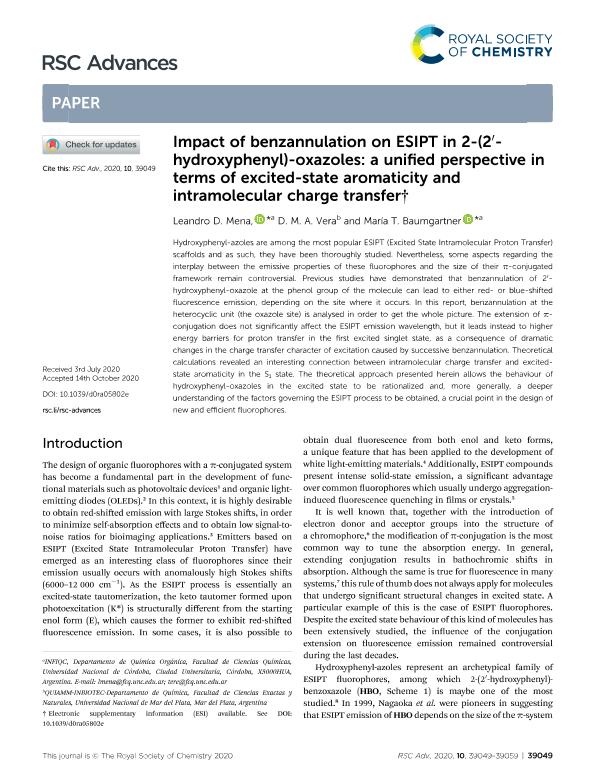Artículo
Impact of benzannulation on ESIPT in 2-(2′-hydroxyphenyl)-oxazoles: A unified perspective in terms of excited-state aromaticity and intramolecular charge transfer
Fecha de publicación:
10/2020
Editorial:
Royal Society of Chemistry
Revista:
RSC Advances
e-ISSN:
2046-2069
Idioma:
Inglés
Tipo de recurso:
Artículo publicado
Clasificación temática:
Resumen
Hydroxyphenyl-azoles are among the most popular ESIPT (Excited State Intramolecular Proton Transfer) scaffolds and as such, they have been thoroughly studied. Nevertheless, some aspects regarding the interplay between the emissive properties of these fluorophores and the size of their π-conjugated framework remain controversial. Previous studies have demonstrated that benzannulation of 2′-hydroxyphenyl-oxazole at the phenol group of the molecule can lead to either red- or blue-shifted fluorescence emission, depending on the site where it occurs. In this report, benzannulation at the heterocyclic unit (the oxazole site) is analysed in order to get the whole picture. The extension of π-conjugation does not significantly affect the ESIPT emission wavelength, but it leads instead to higher energy barriers for proton transfer in the first excited singlet state, as a consequence of dramatic changes in the charge transfer character of excitation caused by successive benzannulation. Theoretical calculations revealed an interesting connection between intramolecular charge transfer and excited-state aromaticity in the S1 state. The theoretical approach presented herein allows the behaviour of hydroxyphenyl-oxazoles in the excited state to be rationalized and, more generally, a deeper understanding of the factors governing the ESIPT process to be obtained, a crucial point in the design of new and efficient fluorophores.
Palabras clave:
ESIPT
,
PROTON TRANSFER
,
CHARGE TRANSFER
,
AROMATICITY
Archivos asociados
Licencia
Identificadores
Colecciones
Articulos(INBIOTEC)
Articulos de INSTITUTO DE INV. EN BIODIVERSIDAD Y BIOTECNOLOGIA
Articulos de INSTITUTO DE INV. EN BIODIVERSIDAD Y BIOTECNOLOGIA
Citación
Mena, Leandro Daniel; Vera, Domingo Mariano Adolfo; Baumgartner, Maria Teresa del V.; Impact of benzannulation on ESIPT in 2-(2′-hydroxyphenyl)-oxazoles: A unified perspective in terms of excited-state aromaticity and intramolecular charge transfer; Royal Society of Chemistry; RSC Advances; 10; 64; 10-2020; 39049-39059
Compartir
Altmétricas




